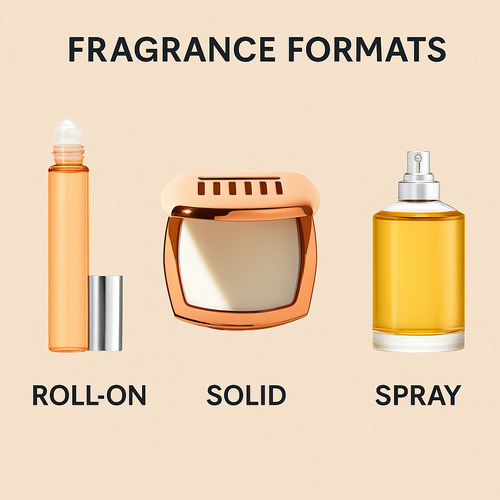The world of perfumery can seem confusing at first glance: you have to consider everything — from the notes you love to the concentration of fragrance in each bottle. And that’s not all — there are also different formats: roll-on perfumes, sprays, and solid perfumes. It might seem like a simple matter of packaging, but in reality, each option has its own characteristics: the method of application, longevity, and even how the fragrance unfolds on your skin throughout the day.
Fortunately, no matter which format you choose, one thing is certain — you’ll smell amazing. To help you navigate all the details, we’ve prepared a comprehensive guide based on expert opinions. In it, you’ll learn the differences between perfume formats, how to choose your ideal option, and what to pay attention to when purchasing. After all, choosing a new fragrance is much more enjoyable when you have a clear plan.
What are roll-on perfumes?
Roll-on perfumes are created by blending a fragrance composition with a liquid carrier, which ensures a soft and even distribution of the scent on the skin. This format is usually applied directly to pulse points — wrists, neck, or behind the ears. Thanks to the built-in roller applicator, application is precise, convenient, and economical.
What are spray perfumes?
Spray perfumes are the most popular fragrance format, and it’s no coincidence. This method of application allows you not just to put perfume on your skin but to envelop yourself in a fine aromatic cloud. By spraying the fragrance into the air and walking through the mist, you create a soft, even coverage of scent.
Spray perfumes come in different forms: from light body mists to classic perfumes with an atomizer. Each type differs in the concentration of the fragrance composition, which directly affects the scent’s longevity and intensity.
Eau de Parfum for Women
Eau de Parfum for Women
Eau de Parfum for Men
What are solid (or dry) perfumes?
Solid perfumes are gaining popularity, offering a convenient and portable alternative to traditional sprays. Unlike eau de parfum, solid perfumes are made on a different base — usually wax or a thick gel-like substance that holds the fragrance. These perfumes are often placed in small containers made of soy wax and can resemble dry scented candles. The aromatic wax is applied directly to the skin — most commonly on the wrists or neck — allowing you to enjoy the scent anytime.
How to Choose the Right Perfume Format
Choosing a new fragrance primarily depends on your habits and personal preferences. Sprays allow the scent to unfold in the most expressive and delicate way, rollerball perfumes are valued for their compactness and convenience while traveling, and solid perfumes are perfect for those who don’t want to carry a glass bottle. Remember: there are no strict rules — there’s no wrong choice. However, factors such as fragrance concentration, alcohol content, and preferred notes can influence your decision.
Fragrance Concentration
The concentration of a fragrance depends on the product format. Rollerball perfumes contain fewer aromatic components and have a more oily texture since the scent needs to pass through the roller applicator.
Solid perfumes, on the other hand, can vary in concentration: they are made from soy wax, cream, or soap bases, making them ideal for a subtle, unobtrusive scent rather than a long-lasting aroma throughout the day.
Sprays are characterized by higher concentration: formulas in the form of extracts, elixirs, or perfumes provide an intense and long-lasting scent. Eau de parfum, with its higher fragrance concentration, generally lasts longer than a body spray.
The Most Alluring Women’s Fragrances
The Most Alluring Men’s Fragrances
Alcohol Content
Alcohol in perfumery is most commonly used as a preservative and plays a key role in the way a fragrance unfolds. It evaporates quickly in compositions such as eau de parfum, helping the scent to disperse evenly when applied. This rapid evaporation creates an initial “burst” of the fragrance and influences how it develops and settles on the skin over time.
Spray perfumes based on alcohol offer the best longevity: they last longer than roll-ons or solid perfumes. Solid perfumes have the shortest shelf life, followed by roll-ons, while alcohol-based sprays remain the most stable and long-lasting.
Choosing a Fragrance by Season and Occasion
Experts recommend selecting fragrances according to the season. In spring and summer, lighter, fresher, and brighter compositions are preferred, creating a sense of joy, lightness, and playfulness. In contrast, in autumn and winter, it’s better to opt for warm, rich, and deep scents that evoke coziness and comfort.
Fragrance choice also depends on the occasion. For a party, scents that boost confidence and energy are ideal. For a date, warm and sensual notes work best, while for workouts, fresh and invigorating fragrances help maintain activity and a good mood.
The choice of fragrance format primarily depends on personal preference—each format has its own effect and purpose, so it’s impossible to say that one is universally better than another. Individual skin chemistry also affects how the scent unfolds and its longevity.
Roll-on perfumes are perfect for travel: they’re convenient to carry in a pocket or purse for a quick fragrance refresh. Solid perfumes melt on the skin, allowing you to massage them into your body and release the scent without alcohol. Sprays are versatile and suitable for any occasion, providing easy and even application.
If you can’t decide on a single format, experts suggest combining them: use solid perfume as a long-lasting base, spray for a bright initial sillage, and roll-on for convenient touch-ups throughout the day.

